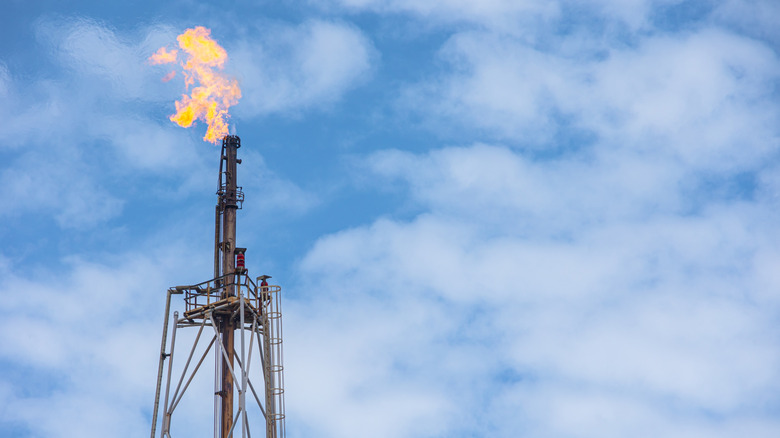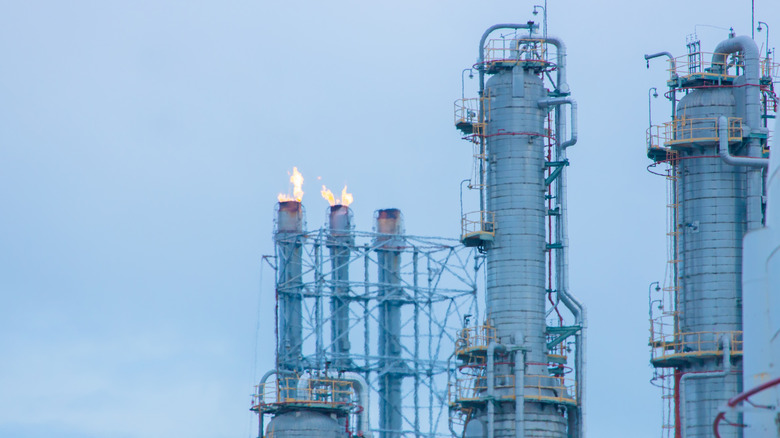Why Do Oil Rigs Have A Burning Flame At The Top?
If you've ever seen an offshore oil rig floating in the ocean, you've probably noticed those tall towers with flames shooting out of the top. Those towers are called the flare stack, and the flames are a result of gas flaring — an important part of many oil and gas facilities. But what exactly does the flare stack do, and what sort of impact does gas flaring have?
To be clear, this flame is not a sign of something gone wrong — it's actually the opposite. It's a safety measure. Defined simply, gas flaring is the controlled burning of natural gas released during oil extraction. When oil is drilled, it typically comes with methane and other associated gases that were also trapped in the underground reservoir. When there's no infrastructure in place to capture or transport this associated gas, energy companies will just burn it off at the surface using flare stacks.
Pressure in the oil wells can build up really quickly. Without a proper release, that pressure could lead to dangerous explosions. By flaring, the excess gas can be burned off safely so the pressure can be relieved. It's extremely wasteful, but it's often the quicker, safer, and cheaper way to deal with the gases in high-pressure environments.
The environmental impact of gas flaring
Associated gases put oil rigs in a real lose-lose scenario: burning the gas is an environmental hazard of its own, but the alternative — venting the gas directly into the atmosphere — is just as bad (if not worse). Methane alone is over 25 times more potent than carbon dioxide when it comes to trapping heat in the atmosphere. Flare stacks help reduce this environmental impact by burning the methane into carbon dioxide and water.
Nevertheless, this still has a significant environmental impact. In 2021 alone, 144 billion cubic meters of gas was flared globally. That's around 400 million tons of carbon dioxide: the same as nine trillion miles driven by cars. Flaring also gives off soot: a leading cause of global warming, as it speeds up ice melt in Arctic regions by darkening the snow and reducing its reflectivity. As a matter of fact, studies show flaring may be responsible for up to 40% of black carbon deposits in the Arctic.
Is there an environmentally friendly alternative to gas flaring?
There's one way to deal with associated gas that hasn't been mentioned yet: Capturing and transporting it. Many oil companies resort to flaring simply because capture and transport is expensive (especially in remote or smaller-scale operations). The process needs pipelines, processing facilities, and stable markets — none of which are a guarantee, especially in developing countries or offshore rigs. Burning the gas is the cheaper, faster, easier solution.
However, global efforts to eliminate routine flaring by 2030 are currently underway. The World Bank's Zero Routine Flaring initiative is leading the charge to push countries with the most oil rigs to adopt more environmentally friendly alternatives (like re-injecting gas back into the reservoir to increase oil output, using it to generate electricity on-site, or converting it into liquefied or compressed natural gas). Some countries are also turning to regulatory pressure, such as steeper taxes on flaring, to force rigs to cut back on the nasty habit.


